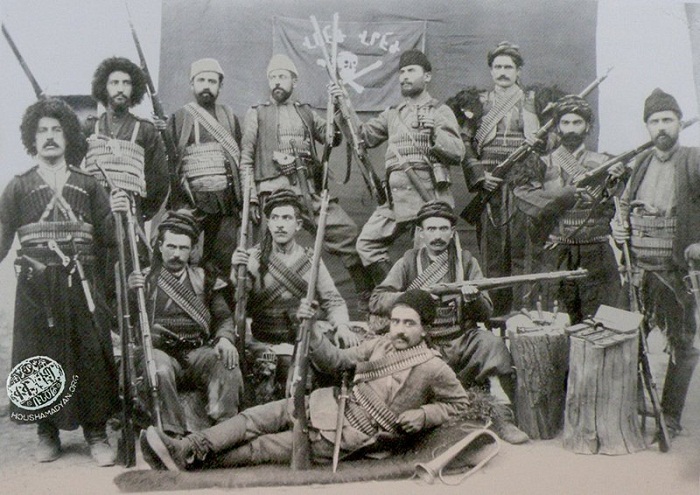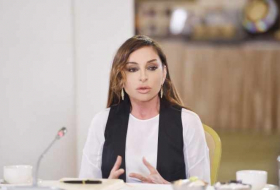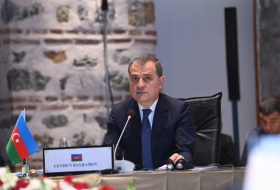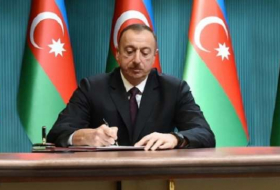The study of the aims and strategies of the Armenian minority organizations from a historical perspective during the phase of New Armenian Terrorism (1973-85) shows that they had all assumed the character, aims and functions of a terrorist organization.
Their activities were directed towards the objectives of inciting and perpetrating revolts, revolutions and acts of terrorism.
It has already been noted above that the Dashnaks who had become organized in the 1890s, had adopted a program based on terrorist strategies, such as forming gangs, demoralizing the target Ottoman population, killing the Turks and undermining their sovereignty, arming the Armenian minority groups in preparation for uprisings, revolts and terrorism, forming revolutionary committees and murder squads, and destroying governmental institutions. After seizing power and establishing an Armenian Republic (1918 - 1920) within a year of the Russian Revolution, in the region where Soviet Armenia is situated today, the Dashnaks engaged in diplomatic activities and tried to assert themselves as a legitimate power; nevertheless, the fundamental terroristic philosophy never disappeared and resurfaced years later in 1972 with the formation of a subsidiary group named the Justice Commandos for Armenian Genocide. The operations of this group are well-known to everyone, not least to the non-involved Armenians on whom they exert constant pressure.
Similarly, the Marxist Hunchak organization has shown that it too endorses terrorism by the protection and support it gives to ASALA, the principal terrorist organization of the period 1973 1985. It is noteworthy that the Hunchaks provided the inspiration and intellectual impetus for the creation of this group.
For terrorist organizations, the Armenian cause, or the Armenian issue no matter what interpretations may be placed upon it has been identified with terrorism whilst the ideals or aspirations of the Armenian people have been reduced to hostility against the Turks and Turkey, to be pursued through vindictive acts and bloodshed.
The Armenian terrorist organizations are, as a rule, formed by a small number of activists, who control the central administration. The operations agreed upon by the central administration are carried out by a number of teams; each entrusted with specific duties.
When required for propagandist purposes, these teams are made public under a variety of names, which serves the purpose of creating an impression of large numbers and widespread activity.
Terrorist organizations need not be situated in one specific physical or geographical location. They could be dispersed in several countries, or scattered over the same country. Although this situation on the surface gives an impression of a more democratic and open structure, yet, in reality, such organizations observe a strict discipline imposed by a central organization.
Another characteristic of the terrorist organization is their tendency to split into a number of smaller groups both because of their different functions and also as a result of rivalries between their members and their leaders. One outcome of this phenomenon is that each group that breaks away forms its own affiliate organization. Hence, there is an apparent mushrooming which once again produces the impression of proliferation.
Secrecy forms one of the basic tenets of these organizations. However, at times, particularly through the instrumentality of the subsidiary team, disclosures are made in order to publicize the activities performed as an occasion for propaganda. This policy also serves the aim of concealing the main centre from detection, which can thus continue its activities in security. For the same reasons, the teams make announcements both before and after committing crimes and take responsibility for them.
In all Armenian terrorist activities, terrorism goes hand in hand with psychological coercion. In fact, the former is a phase in the process of applying the latter. Terrorism can be used as a means of propaganda, as well as an instrument of oppression, intimidation and retribution. The second use of terrorism is reserved for those who oppose the activist organizations or disobey its commands. The majority of non-involved Armenians are subjected to such pressures.
These organizations possess an immense store of expertise and experience in the fields of public relations, communications and the media. Moreover, they have close contacts with the institutions and the people who disseminate information and influence public opinion. Such expertise and contacts provide organizations with opportunities for survival and gradual expansion.
The terrorist organizations enjoy the open or secret support of one or more states. These may use them either as an instrument to further their own interests or as a means of covering up their secret organizations or propaganda units.
Hostility against Turkey and the Turks provides the terrorist organizations with a motive for their existence and survival, as well as serving to rationalize their claims and demands. However, in countries, which have close relations with Turkey, the hostile reactions apparently provoked by these organizations tend to be short-lived. Indeed, in such cases, particularly when terrorism takes as its target not only Turkey but also the country where it operates and its citizens, it has to be assumed that the activists are aiming at intimidating their opponents, rather than carrying out hostile operations against the host country.
In retrospect, Armenian terrorism appears to have three main objectives: 1) to compel the Armenians to join the ranks of the activists by exerting pressure on them, thus securing their support, 2) to influence world public opinion by convincing it of the might and scope of Armenian terrorism, and 3) to prepare the ground for hostility against Turkey in case of future conflicts of interests and political confrontations on the international scene. The nineteenth-century myth of an enslaved and impoverished minority deprived of its rights and the twentieth-century theme of a nation subjected to massacres and genocide have both been used in order to have access to sources of power in international relations.
These sources will probably be enlisted in the service of nations who are Turkey`s rivals or even by international institutions for specific ends. What, in fact, is not known among the aims of the terrorist organizations is the to which the opportunities, that arise by instigating international conflicts, will ultimately be put. This is no other than the attainment of the goal or ideal, which they expect to be realized through its own momentum in the course of a historical process outside their immediate sphere of influence.
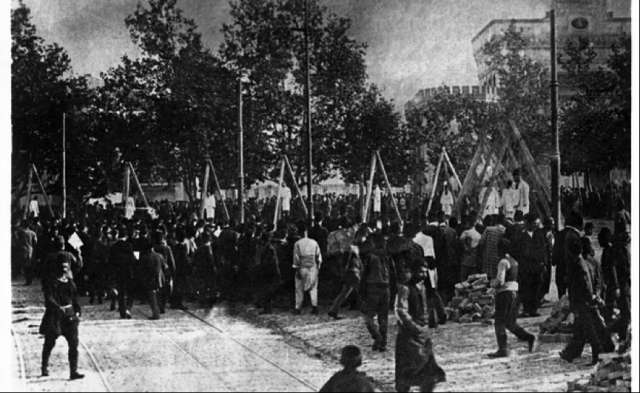
NEW ERA OF TERRORISM (1973 - 1985)
In the era of New Armenian Terrorism, Dashnak and Hunchak organizations function as the main centres which encourage, promote and train terrorist groups so that they can develop and expand over new areas and increase the scope of their targets. Their leadership extends to the formation of new terrorist groups and teams, providing man-power, intellectual and moral support for the newly founded organizations, and the preparation of the ground for their activities through the establishment of contacts and relations. Apart from these, ASALA, short for the Armenian Secret Army for the Liberation of Armenia constitutes another major terrorist organization. It has succeeded in having its name mentioned more than that of any other group, and as such has become almost synonymous with Armenian terrorism. Together with the traditional organization and their offshoots, ASALA, too, is the initiator of the new era of terrorism. As has been noted above, despite its seemingly independent status, ASALA is affiliated to the Hunchaks, deriving its moral and intellectual strength from them, as well as making use of their established contacts and relations.
Seen from this angle, it may indeed be claimed that terrorism, as we see it in our day, is a continuation of the earlier tradition of terroristic activities, which was revived under the favourable circumstances of the sixties, and, making use of the opportunities that were created anew, once again embarked upon its mission of hostility against the Turks, engaging in criminal acts of the greatest inhumanity and cruelty.
One of the attempts at rationalizing terrorism is provided by Michael M. Gunter in his study on "Armenian National Liberation", where he claims that the peoples of many different countries in our day support the struggles of the terrorists and believe in the validity of the reasons for which they take action. Similarly, Gerard J. Libaridjian, the editor of the Armenian Review and director of the Zorian Institute for Contemporary Armenian Studies situated in Cambridge, Massachusetts, explains the reasons that lie behind Armenian terrorism as follows: "The reluctance of Turkey and the major world powers to recognize the exasperation of the Armenians, even after sixty years spent in attempts at establishing peace, has resulted in bringing about a new era of terrorism." Agop Agopian, the ASALA leader, on the other hand, argues that Armenian terrorist activities emerged "after it became evident that the policies pursued by the traditional parties had failed:"
In the light of these statements, it becomes clear that those who share such views, present the situation as if it were one that entails a choice between peaceful or violent methods of pursuing the Armenian cause; they ignore the phenomenon of Armenian terrorism as a continuing historical process. Moreover, they fail to explain from what source they derive the right to launch such violent attacks against Turkey and to instigate revolutions, revolts and warfare with the aim of destroying its unity, nor do they tell us who invests them with this right or authorizes the exercise of such acts. The terrorists claim a right to perform acts of violence - the right to cherish animosity, seek revenge and commit assassinations - and to exercise this right freely. They pretend not to be aware of the fact that the Armenian activist organizations were engaged in terroristic operations right from the start. For the new era of terrorism is clearly a revival of the older and traditional phase of terrorism, reactivated as a result of preparations made in the sixties through propaganda campaigns and demonstrations, as a means of manipulating the aspirations of certain countries and peoples over Turkey and taking advantage of the attitudes of rivals exploiting her political and economic difficulties. One need not doubt, however, that the era of New Armenian Terrorism will come to the same end as the former. Yet, in the meantime, the Armenian people themselves are undergoing the humiliation and anguish of being branded as terrorists in the eyes of the world and observe with anxiety the course taken by the events. This is an aspect of the situation which the terrorist organizations do not wish to see, or perhaps, one which their mentors refuse to see. In this way, regardless of the harm caused, propaganda and psychological coercion campaigns continue to be waged on a large scale.
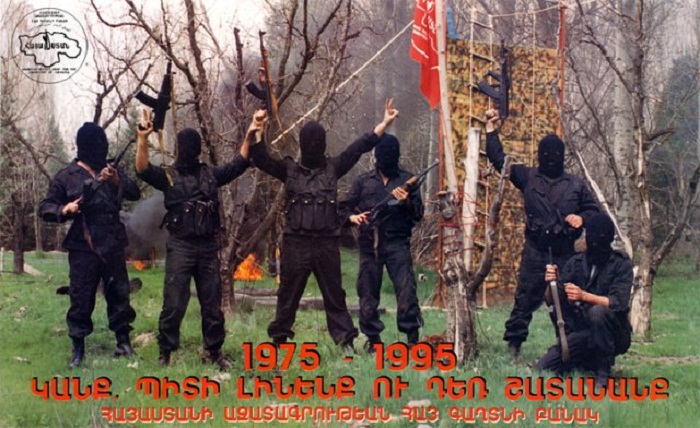
HINCHAK
The Hinchak (Sound of the Bell) Committee was established in Switzerland in 1886 by Avedis Nazarbelg and his wife Maro, Caucasian Armenians of Russian citizenship, and a group of Caucasian students. They also started the publication of a newspaper titled Hinchak to propagate the ideas of the Committee, of which the leaders and members were Armenians from Russia. It selected the Eastern Anatolia as its field of operation and, after a while, its headquarters was moved from Switzerland to London.
The Hinchak Committee's programme was socialist, Marxist and Centralist It adopted the principles of Karl Marx. Though it qualified itself as a social democrat, its political programme is reminiscent of the communist manifesto. The Committee opened in 1890 a branch office in Istanbul with subdivisions at various provinces of the Ottoman Empire. The main political goal of the Committee was to save the Armenians in Turkey from the Turks, those in Iran from the Iranians, the Russian Armenians from Russia and to do away with all the capitalists in these countries.
Its PROGRAMME:
The working and producing classes constitute the great majority of humanity. The emancipation of these classes from the exploitation of a rich and sovereign minority will be achieved through the seizure of all production factors, soil, factories, mines and transports. The independence of the producing classes means the salvation of the entire humanity and general and economic welfare.
The achievement of this goal and its physical implementation requires the organisation as dictated by its own desiderata of working classes in all civilised countries and the accomplishment of the communist revolution everywhere using the general political capabilities at their disposal. Thus will be eliminated all other social classes and the producer classes will create a socialist order. In this new structuring, the people will make their own laws and display its might.
(…)
The Armenians today are under the subjugation of the classes run by monarchic rulers. Their administrative, fiscal and tax systems are self-destructing for themselves. Around these monarchies, all ancient economic and administrative structures wither away while the capitalist management systems are used in the production.
The introduction of a socialist order embracing the Armenian social democrats and all Armenians at large is admitted to be a distant goal under the prevailing conditions and, therefore, all tendencies and toils require a nearer target. It is this nearer target that created the Armenian Revolutionary Hinchak Party, which aims at the following:
a) To foment the revolution.
b) To annihilate the sovereign classes of the absolutist administrations.
c) To save the Armenians from slavery.
d) To strengthen the Armenians for entering into the political realm.
e) To eliminate the hurdles preventing the economic and cultural advancement of the Armenians.
f) To prepare an environment where the working classes will be able to freely express their opinions.
g) To improve the unbearable working conditions.
h) To provide the workers with knowledge on their own class for enabling them to organise into a special political entity of their own.
i) To facilitate the work by the people to attain the distant goals.
In line with these goals, the nearer targets of the Hinchak Committee are to destroy the monarchic administrations and to replace them by democratic and oligarchic regimes, for which the following conditions were set:
a) A constituent assembly should be elected, for true popular representation, by direct votes of all citizens. This assembly should have the power of examining all political, economic and other issues and legislation of the country in question and resolving on them.
b) Provinces should be given a large autonomy.
c) Full independence should be provided for the people.
d) The people should be able to elect the government, security, justice and education officials in public service.
e) Every citizen, irrespective of nationality should have the right to be elected to provincial and autonomous administration positions.
f) All citizens irrespective of nationality and religion differences should be equal before the law.
g) Full freedom of press, expression, assembly and election should be recognised to all citizens.
h) Homes of all citizens and citizens themselves should enjoy freedom from molestation.
i) The churches should be dissociated from the State and maintain their existence solely through the help of persons of their own congregation.
j) Military service should be performed by all citizens as militia members during the peacetime.
k) A secular and compulsory education system should be implemented and the State should assist the poor in this field.
Since the improvement of the people’s economic lot is involved, the following conditions must be fulfilled by securing the political rights listed above and based on them:
a) The existing taxation system should be replaced by one based on the payment power.
b) The indirect taxes should be abandoned altogether.
c) Peasants should be absolved of all of their debts.
d) Farm machinery should be provided with the help of Government and of the people, their proper use should be taught and they should be given to the people themselves.
e) Agrarian partnerships should be established among the people for the purpose of ensuring the sale of farm products and purchase of such amenities as seeds, fertilisers and the like.
f) Vehicles should be provided for all kinds of transportation and contacts.
g) The Government should prevent the exploitation of working classes and adopt laws for this purpose.
Regions where the Armenians hold the majority are also the largest areas of our country.
The Armenian cause acquired the status of a right by the 61st article of the Berlin Treaty and under the pressure of other international conditions and was recognised by the European Powers.
The political, economic and financial débâcle of the Ottoman Empire together with the internal uprisings appear to have been contributing factors that prepared its doom with also the assistance of the European Powers. It is, therefore, necessary that the following should be achieved to comply with the requirement of a historical necessity as the Ottoman territories in European continent were seized by other States:
a) The Armenian rebels will concentrate their efforts for defending the Armenian cause and achieving the short-term goals.
b) The area where the revolution will be launched will therefore be that in which the Armenians live.
c) Since the future of Armenians needs to be separated from the Ottoman Empire’s destiny, the first condition of the short-term goal will be the Armenian independence.
For attaining the short-term goal, the Armenians decided that the peace and order should be interrupted and altered by a revolution and a war should be started against the Turkish Government and the revolution’s tools were indicated as follows by the Armenians:
a) A propaganda campaign will be initiated among the people and particularly the workers through the press, books and speeches, to broadcast the revolutionary ideas of the Hinchak party, to create revolutionary organisations and to foment mutinies.
b) The terror will be used as a weapon to punish the Turkish secret police members, informers and traitors and the terror will be used as a shield for the defence of revolutionary organisations and a guard against the rascals that persecute the people.
d) An armed force will be kept in readiness and spearheading legions will be formed to defend the Government and the people against the soldiers and tribal groups and the legions will be used as the advance units in an uprising.
e) Suitable occasions will be created for instigating an uprising.
f) A general revolution organisation, consisting of several regular units commanded by a single central headquarter and marching in unison toward the common goal, within the context of which has been prepared a regulation for defining the responsibilities and powers of these units and the organisation and activities of the Hinchak Committee.
g) Efforts will be made to secure the alliance of other minorities having the same destiny as the Armenians and to have them to join the Armenians our common enemy the Turkish Government. The greatest objective of the Hinchak Committee will be to establish a federation similar to the Swiss one after throwing off the Ottoman yoke.
The Hinchak Committee operating under this political programme carried out intense Marxist propaganda, especially among the working classes. Both the youth and religious leaders, adventurers and unemployed went out of their way to foment unease and to foment a revolution while the Committee’s leaders concentrated their efforts on creating an Armenian proletariat. These efforts, however, did not go beyond socialist propaganda under the then prevailing conditions in Turkey. Persons coming from Russia and other countries with a flair for such work often took part in these activities.
The Armenian actions led in this country to many bloody incidents of which the relics will not easily be forgotten. Renowned militants like Shimavon of Tbilisi came from Geneva, S. Danielian arrived from Iran, Rupen Hanazat of Russia showed up from Trabzon and H. Megavorian appeared from Batoum to organise the subdivisions of the Hinchak Committee. Other revolutionary organisations formed in Istanbul prior to 1980 eventually joined this new setup.
It, therefore, becomes evident that the fate of Armenians in Turkey was left to the discretion of Russian Armenians. The pressure was being exerted on those refusing to join the Committee and to grant monetary aid and many of them were being murdered. Thus, the organisation rapidly started to spread to the other Anatolian provinces.
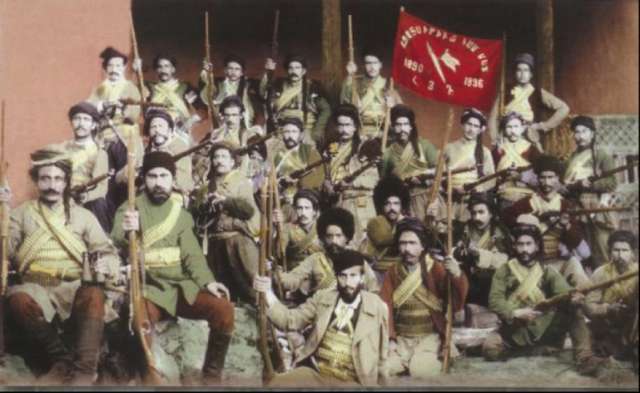
ACTIVITIES
The charter and programme of the Hinchak Society were printed in Istanbul in 1909, submitted to the Ministry of Interior pursuant to the Law on Associations and received the approval letter no 90 of 8 February 1909. The charter consists of five parts.
The ledger of resolutions seized by the security forces show that the following resolutions were adopted in q910, 1911, 1912 and 1913:during operations:
a) Efforts will be spent to secure weapons, ammunition and explosives.
b) Weapons training will be given by Marufian, Yavruian and Candan.
c) Propaganda work will be accelerated.
d) Relations will be established with the Tashnak Committee.
e) Similar relations will be maintained with the Union and Progress Party.
f) Support will be given to the Orsfan, Cang, Gochnak, Jurachak, Panchak, Badami, Tejoheng, Maro and Paros bands in Van.
The Hinchak Committee held its third congress in Turkey on 24 July 1914. The congress, held with 28 delegates from 51 branch offices, was chaired by Cangulian with Tancutian as the secretary and the following decision was adopted:
"Taking into account the great responsibility necessitated by our goals and the dangers involved, and in an attempt to prove that we are a civilised people, care will be exercised for always avoiding adventures and actions not thoroughly planned in advance, and we will bear in mind the fact that a balanced attitude and proper means are the most suitable tools for reaching our final objectives. "
On the basis of this decision, the Hinchak leaders started to leave Turkey after 1896 and disagreements soon arose among them, with the result that the party broke into two factions. One faction was called the true Hinchaks (Nazarbeg’s followers) and the other came to be known as the reformed (Veragasmial) one. The latter group was led by an Armenian named Arpiar Arpiarian.
It seems that both factions acted in obedience to the beliefs and opinions of their leaders rather than under valid principles and programmes. The disagreement among them often led to street fights, some of them were beaten and many were killed.
The Armenian people, realising that the Hinchaks were Marxists, gradually withdrew themselves from it. The divergence came to a head in 1902 when militants from both sides began murdering each other on streets in England, Russia, Egypt, Bulgaria, Caucasus and Iran. Though some small bands continued bearing the name of Hinchak, they lost their previous strength after the Van resurrection. Another factor contributing to the disappearance of the Hinchak Committee was the fact that several Hinchak leaders had seen the true intentions of the Russians and left the organisation.
AzVision.az








